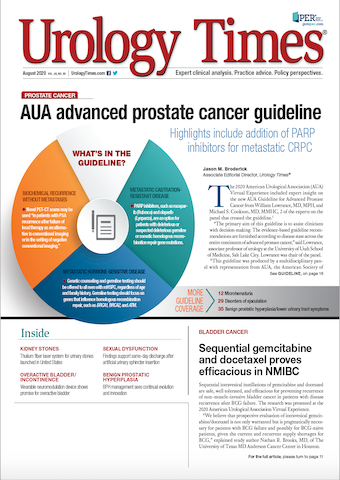Publication
Article
Urology Times Journal
Quality performance initiative may improve TURBT outcomes in bladder cancer
Author(s):
Increased usage of bladder diagrams was observed following implementation of the program.
In “Journal Article of the Month," Badar M. Mian, MD, offers perspective on noteworthy
Badar M. Mian, MD

research in the peer-reviewed literature. Dr. Mian is professor of surgery in the division of urology at Albany Medical College, Albany, NY.
Transurethral resection of bladder tumor (TURBT) is probably the most technically challenging procedure among all the endoscopic urological procedures of the upper and lower urinary tract. Often viewed as a basic urological procedure, TURBT has long been associated with incomplete resection of tumor, incomplete staging, and early recurrence, especially for non–muscle invasive bladder cancer (NMIBC). Many experts have suggested TURBT quality performance indicators over the past 20 years, but there have been no specifically implemented quality improvement programs. In a recently published study, Mariappan et al present the outcomes of prospectively developed quality performance indicators (QPIs) for TURBT that were implemented nationally in Scotland in 2014 to improve compliance with guidelines and improve outcomes.1
Of the 4246 newly diagnosed bladder cancers (from April 2014 to March 2017) in Scotland, 2689 were diagnosed at the collaborative hospitals, of which 1925 (69%) were diagnosed as NMIBC on TURBT. Multiple and larger (≥ 3 cm) tumors were noted in 32% and 33% of cases, respectively. Low-grade Ta and high-grade Ta or T1 tumors were identified in a near-equal number of patients.
The 3 quality performance indicators specifically related to initial TURBT included use of a bladder diagram showing tumor location, presence of detrusor muscle on initial TURBT specimen, and use of a single instillation of mitomycin C (MMC) after TURBT. The outcome measures after implementation of QPIs for initial TURBT for low-risk NMIBC included recurrence rate at first surveillance cystoscopy. For high-risk NMIBC (HR-NMIBC), outcomes of interest included either the presence of any residual tumor or T2 (muscle-invasive) cancer on the required re-TURBT. Re-TURBT was not performed in 30% because patients were deemed medically unfit or unlikely to benefit from further surveillance or lost to follow-up.
Annual compliance rate with 3 QPI measures was similar between all of Scotland and the collaborative study centers during the 3-year study period. The most significant increase in QPI compliance was noted in use of bladder diagrams increasing from 33% to 77%. The overall rate of detrusor muscle presence in the TUR specimen and the use of post-TUR MMC did not change during the 3-year study period. The detrusor muscle in the specimen was noted in 80% of cases at the high-volume centers (> 90 TURBT/year), which was significantly higher than the 66% from the low-volume centers (< 60 TURBT/year).
Regarding oncological outcomes as a result of these QPIs, the recurrence rate at first surveillance cystoscopy for the low-grade group improved steadily from 24% to 14% to 12%. Importantly, there was 3-fold reduction in early recurrence in the group with low-grade small tumors after postoperative single-dose MMC. There was a higher (but not statistically significant) rate of early recurrence for cases with multiple tumors and at low-volume centers.
In the T1 and/or high-grade cancer group, re-TURBT showed presence of any residual tumor in 33% of the entire cohort and 35%, 31%, and 31% over the 3-year study period. Muscle-invasive tumor on re-TURBT was noted in 2.9% of cases. On multivariable analysis, tumor size (≥ 3 cm), stage T1, surgeon experience (trainee vs attending), and postop MMC instillation were significantly associated with finding residual tumors, including muscle invasive, on re-TURBT. However, it’s not clear how a single postop MMC instillation would affect the incidence of muscle invasive residual cancer.
Although a bladder diagram with tumor location was used increasingly during the study period, it’s probably the least impactful of the QPIs in this study, as noted by lack of association with any of the oncological outcomes on multivariable analysis. Still, capturing the location and foci of the tumor using either a diagram or a digital image obtained during TURBT is quite easy and can be helpful during surveillance and re-TURBT.
The authors report quite a low and acceptable rate of understaging of muscle invasive bladder cancer (2.9%), which was almost entirely in the group with T1 disease. Overall, residual tumor on re-TURBT of the high-grade, T1 group showed residual cancer in 33% of cases, but the details of the grade/stage or size of residual tumors are not provided. It would be informative to know the rate of high-grade or T1 residual tumors.
It’s likely that some of the increased compliance and resultant improvement in some of the outcomes in this study are due to the Hawthorne effect. It is a well-established phenomenon that there can be significant alteration in behavior (TURBT) of the study subjects (urologists) when they are aware of being observed. Yet, there was no improvement in the residual cancer rate from year 1 to year 3 after implementing QPIs. So, is the nearly 30% residual cancer rate on TURBT the best we can expect, and is that an inherent limitation of TURBT procedure? Could enhanced visualization techniques (blue light cystoscopy, narrow-band imaging) reduce the residual cancer rate? There were no data provided on the preimplementation compliance or outcomes, so it’s not clear whether there was an early improvement in this quality indicator. Even a retrospective review of pre-QPIs implementation data could be instructive about the potential impact on compliance and early outcomes.
High-quality TURBT remains elusive due to limitations posed by the shape of the bladder and instruments and concerns over perforation of bladder, coupled with lack of specific, continued training for this procedure. In contrast, significant strides have been made in the endoscopy for the upper tract and resection or ablation of the prostate with improvements in technology (instruments, energy sources, and imaging).
This appears to be the first endeavor of its kind in which QPI measures for TURBT were developed, implemented, and tracked for compliance to show improvement in early oncological outcomes. This QPI tracking approach may be more feasible in the context of a national health system; such a program may be quite difficult to implement in a large, heterogenous system like that of the United States. Still, large health care systems such as Veterans Health Affairs and the ever-growing consolidated hospital systems are well suited for implementing such quality improvement initiatives. Further, at the local level, tumor registries and tumor boards can easily provide anonymized, nonpunitive reports to the urologists regarding certain quality indicators (detrusor muscle in specimen or recurrence at first cystoscopy) to improve compliance and performance.
Reference
1. Mariappan P, Johnston A, Padovani L, et al. Enhanced quality and effectiveness of transurethral resection of bladder tumour in non–muscle-invasive bladder cancer: a multicentre real-world experience from Scotland’s quality performance indicators programme. Eur Urol. 2020;S0302-2838(20)30511-X. doi:10.1016/j.eururo.2020.06.051

Newsletter
Stay current with the latest urology news and practice-changing insights — sign up now for the essential updates every urologist needs.




























